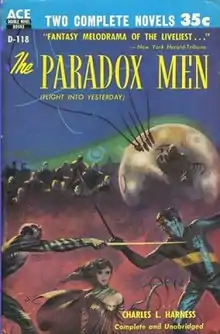The Paradox Men
The Paradox Men is a science fiction novel by American writer Charles L. Harness, his first novel. Initially published as a novella, "Flight into Yesterday", in the May 1949 issue of Startling Stories, it was republished as The Paradox Men in 1953.[1][2] The "science-fiction classic"[3] is both "a tale dominated by space-opera extravagances" and "a severely articulate narrative analysis of the implications of Arnold J. Toynbee's A Study of History."[1] Boucher and McComas described it as "fine swashbuckling adventure ... so infinitely intricate that you may never quite understand what it's about."[4] P. Schuyler Miller described it as "action-entertainment, fast-paced enough that you don't stop to bother with inconsistencies or improbabilities."[5]

In his introduction in the 1967 Four Square paperback reprint of the novel, Brian Aldiss terms it a major example of the "Widescreen Baroque" style in science fiction, and John Clute terms it "the kind of tale which transforms traditional space opera into an arena where a vast array of characters can act their hearts out, where anything can be said with a wink or dead seriously, and any kind of story be told."[1] In Trillion Year Spree, Aldiss and Wingrove report the novel "plays high, wide, and handsome with space and time, buzzes around the solar system like a demented hornet, [and] is witty, profound, and trivial all in one breath."[6] The Paradox Men features the concept of personal force fields which protect people against high-velocity weapons like guns but not against knives or swords, an idea later used in Frank Herbert's Dune (1965).[7]
References
- Clute, John. "Unorthodox science-fiction writer." (Charles L. Harness obituary) The Independent, October 11, 2005.
- "I Did it For the Money." (Charles L. Harness inverview) Locus, December 1998.
- Flight into Yesterday (1953) by Charles Harness - FantasticFiction.co.uk
- Boucher, Anthony; McComas, J. Francis, eds. (September 1953). "Recommended Reading". The Magazine of Fantasy & Science Fiction. Vol. 5, no. 3. p. 101. ISSN 0024-984X.
- Miller, P. Schuyler (April 1954). Campbell, John W. (ed.). "Flight into Yesterday". The Reference Library. Astounding Science Fiction. Vol. 53, no. 2. Street & Smith. p. 147. ISSN 1059-2113.
- Aldiss & Wingrove, Trillion Year Spree, Victor Gollancz, 1986, p.324
- Horton, Rich. "Ace Double Reviews, 18: The Paradox Men, by Charles L. Harness/Dome Around America, by Jack Williamson". sff.net. Archived from the original on June 7, 2011.
Further reading
- Conklin, Groff (January 1954). Gold, H. L. (ed.). "Flight into Yesterday". Galaxy's 5 Star Shelf. Galaxy Science Fiction. Vol. 7, no. 5. p. 132. ISSN 0016-4003.
- McAulay, Ian (November 1964). Peyton, Roger G. (ed.). "The Paradox Men by Charles L. Harness" (PDF). Book Reviews and News. Vector. No. 29. British Science Fiction Association. p. 35. ISSN 0505-0448. Archived (PDF) from the original on 2022-12-24.